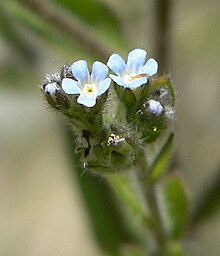| Lappula occidentalis | |
|---|---|

| |
| Lappula redowskii var. redowskii flowers | |
| Conservation status | |
 Secure (NatureServe) | |
| Scientific classification | |
| Kingdom: | Plantae |
| Clade: | Tracheophytes |
| Clade: | Angiosperms |
| Clade: | Eudicots |
| Clade: | Asterids |
| Order: | Boraginales |
| Family: | Boraginaceae |
| Genus: | Lappula |
| Species: | L. occidentalis |
| Binomial name | |
| Lappula occidentalis Greene. (1901) | |
Lappula occidentalis, also known as flatspine stickseed, flatspine sheepburr, western stickseed, Lappula redowskii, or Redowski's stickseed, is a biennial forb native to North America and parts of Europe and Asia. It belongs to the family Boraginaceae. Variants include L. redowskii var. cupulata and L. redowskii var. redowskii, which differ in fruit morphology from the type specimen.
Description

Flatspine stickseed is a flowering herb that reproduces by fruiting. The fruits are divided into four nutlets that have a single row of velcro-like prickles along their edges. The stem is erect, angled, covered in fine hairs that may be appressed to spreading, 5 to 40 cm in height, and may be simple or branched in morphology. Leaves are simple, alternately arranged, with edges that are entire. Both basal and stem leaves are present. Basal leaves are mostly oblong with a rounded tip and tend to wither by flowering time. Leaves along the stem are narrowly lance-oblong and may reach 2 inches long while remaining up to about ¼ inch wide. Stem leaves may lie flat or become folded, are pointed at the tip while rounded at the base, appear stalkless, and diminish in size as they ascend the stem. The flowers of the flatspine sheepburr are blue to purple, radially symmetrical, and arranged in racemes that may extend from 2 to 8 inches as they mature. Each flower is approximately 1/8 inches in diameter, surrounded by five sepals, and is fused near the base. The flowers alternate with bracts along the stem. Bracts, sepals, stalks, and leaves are similarly covered in fine hairs that range from appressed to spreading.
Uses
Western stickseed was used by the Navajo for ceremonial, gynecological, and dermatological purposes.
Distribution
Lappula occidentalis is native to North America and polar regions of Europe and Asia. It may be found in disturbed habitats such as roadsides and along railways. Due to the nature of the fruit of the flatspine stickseed, animals such as sheep may aid in the spread of the forb to habitats disturbed by livestock.
References
- NatureServe (2023). "Lappula occidentalis". Arlington, Virginia. Retrieved 14 November 2023.
- "Lappula occidentalis (S.Watson) Greene". www.gbif.org. Retrieved 17 June 2023.
- ^ Seefeldt, Steven. S.; Leytem, April B. (2011). "Sheep Bedding in the Centennial Mountains of Montana and Idaho: Effects on Vegetation". Western North American Naturalist. 71 (3): 361–373. doi:10.3398/064.071.0304. ISSN 1527-0904. S2CID 58943844.
- ^ "Lappula occidentalis (flat-spined sheepburr): Go Botany". gobotany.nativeplanttrust.org. Retrieved 2023-06-17.
- ^ "Lappula occidentalis (Western Stickseed): Minnesota Wildflowers". www.minnesotawildflowers.info. Retrieved 2023-06-17.
- Webmaster, David Ratz. "Flatspine Stickseed - Montana Field Guide". fieldguide.mt.gov. Retrieved 2023-06-17.
- ^ Webmaster, David Ratz. "Flatspine Stickseed - Montana Field Guide". fieldguide.mt.gov. Retrieved 2023-06-17.
- Webmaster, David Ratz. "Flatspine Stickseed - Montana Field Guide". fieldguide.mt.gov. Retrieved 2023-06-17.
- "Native American medicinal plants: an ethnobotanical dictionary". Choice Reviews Online. 47 (8): 47–4170-47-4170. 2010-04-01. doi:10.5860/choice.47-4170. ISSN 0009-4978.
| Taxon identifiers | |
|---|---|
| Lappula occidentalis |
|
| This article needs additional or more specific categories. Please help out by adding categories to it so that it can be listed with similar articles. (June 2023) |